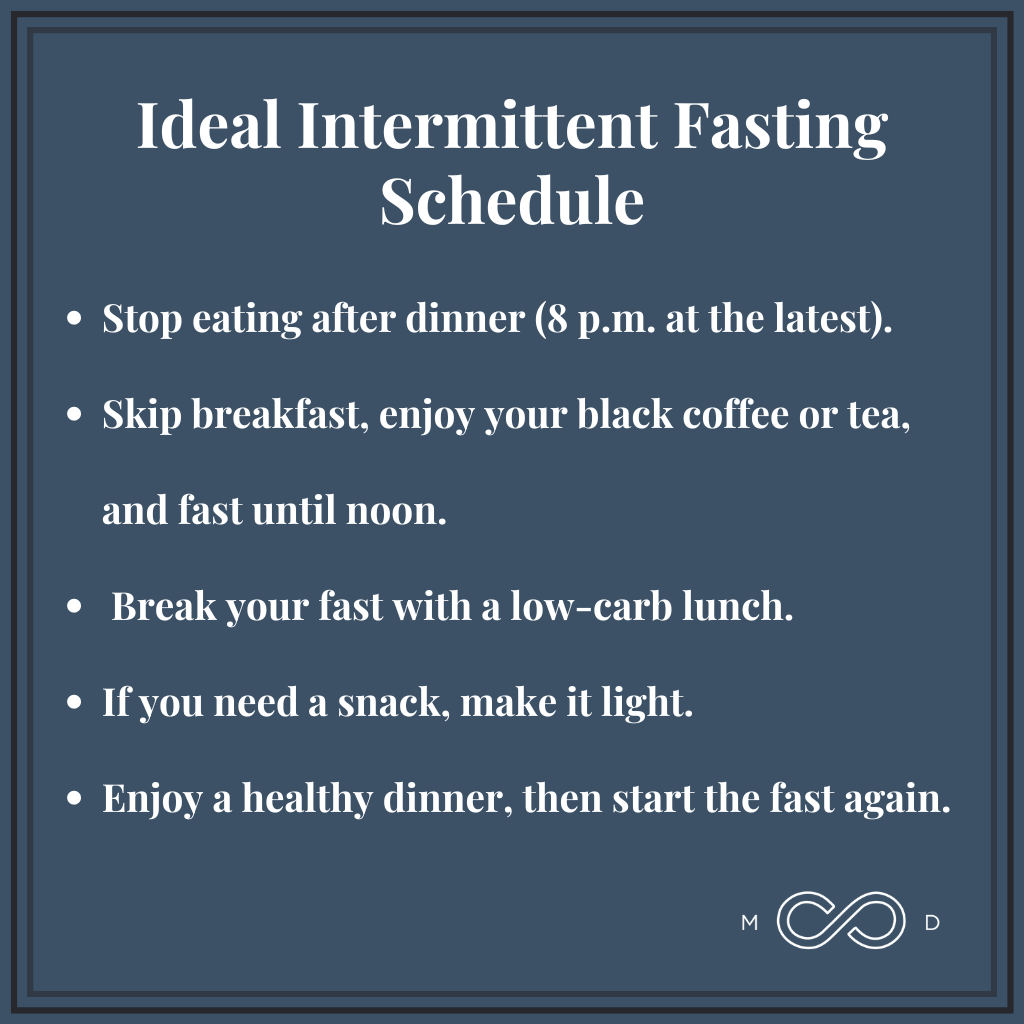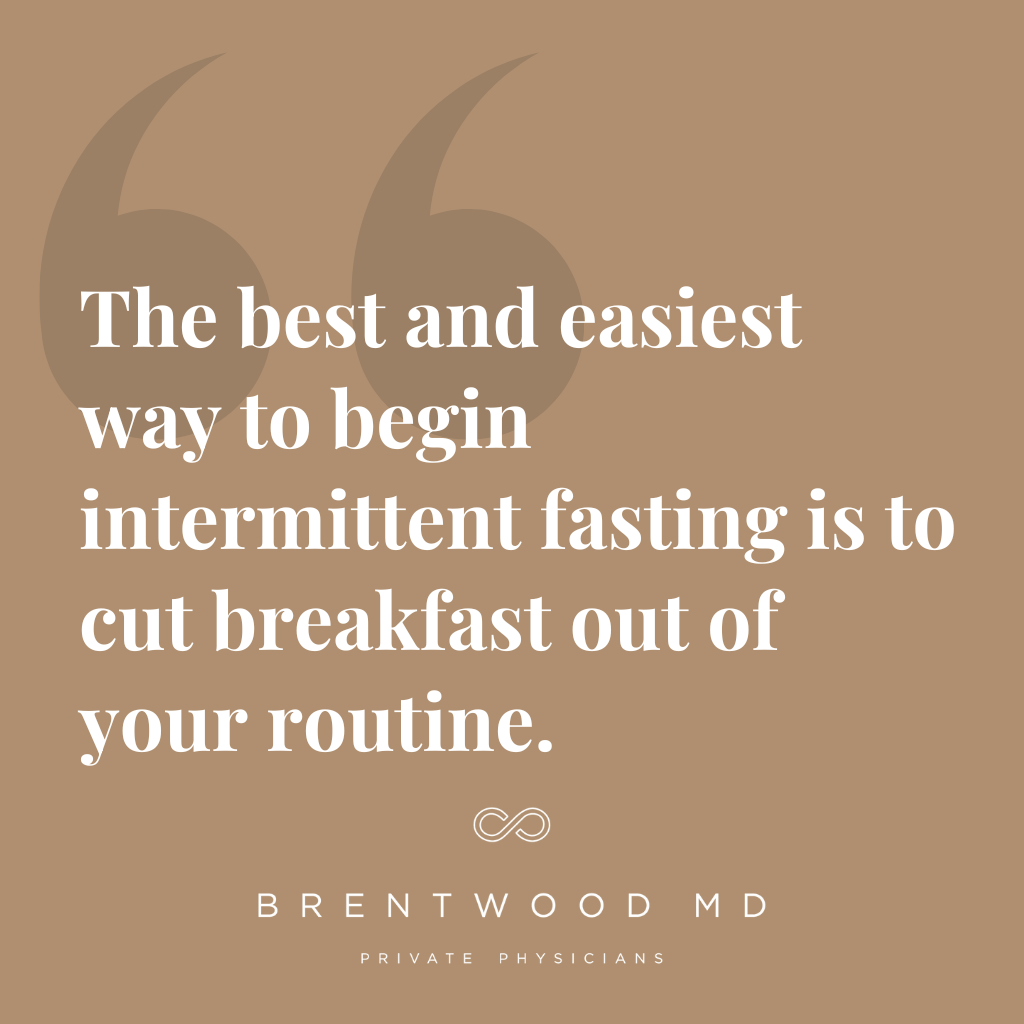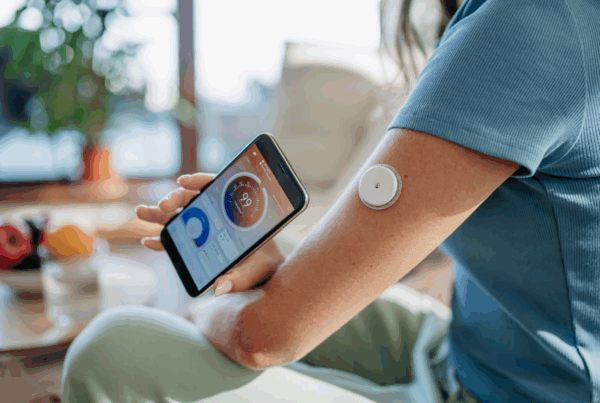The embedded podcast episode was recorded in 2020. Since then, some of our viewpoints on the finer points of intermittent fasting have evolved, which are reflected in the article below.
You don’t need a 400-page diet guide to turn your health around.
You wouldn’t know it from the hundreds of “trendy” diet and weight loss books on Amazon, but improving your health doesn’t have to be complicated.
With all the keto this and gluten-free that cluttering up newsfeeds and bookshelves, it’s no wonder the simplicity of intermittent fasting has attracted attention. Whether you’re overweight, diabetic, or too busy for optimal self-care, intermittent fasting could be a useful tool in your belt for bringing your body back into physiological harmony.
If you’re intrigued by intermittent fasting but not sure how to adopt it into your daily routine, we’re sharing an easy quick-start guide with insights on how to make fasting work for you right here.
What Is Intermittent Fasting?
There’s more than one way to fast, so we first need to clarify what we mean by intermittent fasting and distinguish it from fasting generally.
According to my friend and intermittent fasting pioneer Zane Griggs, “Generally speaking, our dependence on body fat for fuel starts to be elevated after about 12 hours of not taking in any sort of calories.”
So, at its core, intermittent fasting means going at least 12 hours between meals.
After 12 hours, your body mobilizes excess fat to burn energy. In other words, an extended period without eating jumpstarts weight loss by creating a healthy gap in caloric intake and allowing your body a chance to regain homeostasis.
More sustained fasting, in contrast, involves going for 24 hours or longer without food. This is not what we’re talking about here.
According to current research, while fasting for longer windows may similarly promote weight loss, some of those shed pounds are likely lean muscle mass. On top of that, evidence suggests these longer fasting periods may not confer the same longevity benefits as shorter fasting windows.
Fasting is an excellent example, then, of more not necessarily being better. As far as our current knowledge extends, aiming to fast for more than 12 but less than 24 hours appears to be most beneficial with the lowest possibility of side effects.
What Does Successful Fasting Look Like?
What exactly defines successful fasting? Put simply, a successful fast means staying out of your body’s way for 12+ hours. Rather than overloading your system with new calories every few hours, successful fasting gives your body the opportunity to reset, recalibrate, and burn fat.
In our experience, the most effective intermittent fasting calls for a 14- to 18-hour window of no calorie intake, followed by a 10- to 6-hour window of healthy eating. For many people, this is as simple as skipping breakfast.
How to Start Intermittent Fasting
I talk with patients every day who practice commitment and discipline in their careers, finances, faith, and relationships, but who still struggle with one major obstacle: food.
What Zane and I appreciate about intermittent fasting is that it strips away the complexities, questions, and decision-fatigue that surround most popular weight loss and wellness strategies. Absent those difficulties, many people find they can master intermittent fasting and achieve their goals with far less difficulty than they expected.
It’s Not All or Nothing
There’s no one “right” way to start intermittent fasting. Some people can flip a switch and jump right into it, but others need to modify their eating behaviors gradually.
I count myself in the latter group. I was addicted to food, stumbling to the pantry for breakfast each morning before I was even awake. It took me six months to adopt intermittent fasting habits, which included delaying my first meal of the day. My system took time to realize that, no, it didn’t actually need calories first thing in the morning — it just wanted them.
We’re an overfed nation. It’s ingrained in our psyche to start with a huge breakfast and then snack throughout the day. We’ve conditioned our bodies to expect this constant train of calories, so we can’t be surprised if it takes time to acclimate to eating less often.
With intermittent fasting, you have the freedom to determine what works for you — and it may not look the same as what works for someone else. Remember to be kind to yourself and to set realistic expectations for your lifestyle.
If you’d like some ideas for how to start, here are a few possibilities to get you going. Start with:
- Monday, Wednesday, Friday only
- The weekend only
- The minimum 12 hours only
As your body and mind acclimate to your new discipline, you can add more days to your practice or more hours to your fasting windows.
Intermittent Fasting: Step by Step
If you’re ready to try intermittent fasting, below is a step-by-step guide to help you get started.
Step 1: Cut Out Breakfast
Most of us have heard the well-tread American mantra, “Breakfast is the most important meal of the day.” So where does that leave intermittent fasting?
Well, I have good news and bad news. The good news is that you don’t have to eat breakfast to be healthy. The bad news? Cereal manufacturers invented that ubiquitous breakfast “advice,” which has influenced the American diet ever since.
The truth is, the best and easiest way to begin intermittent fasting is to cut breakfast out of your routine.
Your body works its own magic in the morning. Cortisol hormones and adrenals surge to help you wake up, become alert, and generate energy. Introducing food only interrupts these processes.
By skipping breakfast, you take advantage of your body’s natural rhythm to maximize the benefits of fasting.
Step 2: Find the Best Time to Work Out
Many people think they can’t work out while they’re fasting, but the opposite is true. Morning is an excellent time for a vigorous workout! You’re fresh and have hormonal optimization on your side.
Afternoon and evening workouts aren’t always as effective as they could be; you’re fatigued from the day, consumed with whatever new stressors landed in your lap at work, and fighting the urge to slip off your shoes and unwind.
I was loyal to my afternoon workout routine for more than a decade, but switching to an early morning gym schedule has been a game-changer for my fitness. If I don’t work out first thing in the morning, I can practically see the sliding scale as I lose my opportunity throughout the day for a quality workout. Life gets busy, and my body gets drained!
Step 3: Can You Drink Coffee While Fasting? (Relax — You Can!)
I can almost hear the hint of panic in your voice: “Can you still drink coffee while you fast?!”
Yes! Luckily for coffee drinkers everywhere, our favorite morning ritual doesn’t boost our blood sugar or disrupt our fast.
If you can’t stomach the idea of black coffee, then yes, it’s okay to add some creamer… but not much. Your body will have to burn through the fat in that creamer before it can get back to burning your stored fat.
What about coffee drinkers who need to mask the bitterness with sweetener? Zane warns against even all-natural sweeteners, including cane sugar, honey, and agave. They may be “natural” sugars, but they immediately send your blood sugar and insulin levels surging, kicking your body out of fasting altogether.
If you need a hint of sweetness in your coffee, stick to a small dash of Stevia. Most artificial sugars are dangerous because they stimulate cravings and trick your digestive system into preparing for sugar that isn’t coming. This is highly disruptive to the fat-burning process intermittent fasting achieves.
Overall, the question of coffee boils down to your goals. If you’re on a mission to lose 50 pounds, adding cream to your morning brew could slow your progress. But a lightly sweetened cup of coffee is much better than a slice of cheesecake! It’s all about balance.
Step 4: Diabetics, Fasting Is for You, Too!
Zane has worked with many diabetic clients who believed intermittent fasting posed too much of a risk.
But as he explains, “I don’t know of a better way to control diabetes or reverse those symptoms than finding some way to introduce fasting.”
Type 2 diabetes is a disease of elevated blood sugar, and intermittent fasting is an efficient way to lower and balance blood sugar levels through better eating strategies.
In my practice, I believe intermittent fasting might just be the greatest tool my patients have to improve their glycemic control. As long as it’s accomplished using a strategic, physician-guided plan, diabetics may be able to use intermittent fasting to reduce or eliminate their reliance on medication and diminish the effects of diabetes.
Step 5: Use the Rhythms of Fasting to Schedule Lunch and Dinner
So when, exactly, can you eat?
“The simplest approach… is skipping breakfast and having coffee or tea,” Zane says. “If your goal is weight loss, eat a low-carb lunch and dinner.”
Your first meal of the day takes place after your fasting period ends, which means all your eating occurs in a compressed window of about six to eight hours.
“That’s give or take. Make it work with your schedule… If it’s six hours, great. If it has to be nine one day, don’t beat yourself up,” Zane emphasizes.
That’s the beauty of intermittent fasting: there’s no right or wrong. It’s one tool to improve your health in whatever way makes sense with your routine.

If Zane could recommend an ideal intermittent fasting schedule, here’s what he’d suggest:
- Stop eating after dinner (8 p.m. at the latest).
- Skip breakfast, enjoy your black coffee or tea, and fast until noon.
- Break your fast with a low-carb lunch.
- If you need a snack, make it light.
- Enjoy a healthy dinner, then start the fast again.
Once you feel comfortable with the rhythm of intermittent fasting, you can experiment with extending your fast an hour or two longer. Remember, find the schedule and fasting window that works for you.
Step 6: Embrace Dinnertime Community
There’s a good reason most people skip breakfast instead of dinner. Historically, evening meals are social and interpersonal experiences. We use dinner as an opportunity to recover from activities, reconnect with family, and celebrate the end of another day. You don’t need to deprive yourself of that rich experience.
Instead, take the opportunity to practice mindfulness as you eat. You’ll appreciate every bite of your food so much more than you would have if you’d been snacking your way through the day. In his experience, Zane has noticed that intermittent fasting is most successful when we retain dinner as our core food connection.
Step 7: Eat Toward Your Purpose
We’ve established when to open your mouth during intermittent fasting. But once you do, what exactly should you eat? There’s no one correct answer; it all depends on your goals.
If You Want to Lose Weight…
If you’re fasting to lose weight, Zane recommends limiting the amount of carbohydrates and sugars you eat. Make this as easy as possible by planning the meal you’ll use each day to break your fast. Eliminate your ability for poor, impulsive decisions by prepping a satisfying, low-carb lunch. Don’t break your fast when the only thing around is Burger King.
Dinner should include a lean protein and veggie, but it’s okay to add a healthy starch or fat. Remember: You’re rewarding — not punishing — yourself with nourishing, satisfying foods.
If Weight Loss Isn’t Your Main Goal…
If you’re fasting for the sake of health and longevity, focus on eating real foods. What does that mean? If it wasn’t food 100 years ago, it’s not food today.
Steer clear of processed, packaged foods, and read labels to avoid the hidden trap of added sugars. Aim for a good balance of proteins, healthy fats, and veggies. When you indulge in real foods, you automatically control your intake of sneaky carbohydrates.
Step 8: Try 24-Hour Fasting One Day a Week
While I don’t recommend fasting for days on end, periodic 24-hour fasts can be invigorating.
It’s easy to psych yourself out over the 24-hour fast. But once you’re comfortable with intermittent fasting generally, a 24-hour fast one day a week isn’t such a big leap.
A 24-hour fast is easiest to start after dinner. Then, instead of breaking your fast with lunch at 1 p.m., push on for a few more hours to break your fast with dinner and celebration.
I can tell you from personal experience that the first meal after a 24-hour fast is so satisfying. There’s nothing else like it — not to mention the fat-burning and biochemical benefits of giving your body a 24-hour reset.
Step 9: Say “No” to an Intermittent Fasting Cheat Day
Zane doesn’t pull any punches on the topic of intermittent fasting cheat days: “I’m not even sure what the point is.”
A cheat day is equivalent to a binge day for most people, but the effects of the binge don’t disappear after 24 hours. It can take three or four days to recover from the effects of a cheat day, reign in your cravings, regain your energy and focus, and get back on track.
“If your goal is weight loss and you’re trying to get somewhere effectively, why throw it all off with an entire meal of something like pizza or a bunch of pancakes?” Zane asks. A surge of 1,500 calories of junk during an intermittent fasting cheat day will drive you in the opposite direction of your goals.
Indulge, Don’t Cheat
Indulging is different from cheating. A small slice of pie or a couple cookies every once in a while can help you scratch an itch before you turn into a full-blown dessert monster.
For best results, plan your indulgences ahead of time. This will keep you from giving in every time you have a craving. These indulgences can help keep you motivated and boost your mood.
Be Realistic With Yourself
To make intermittent fasting part of your lifestyle and reach your long-term goals, remember to be realistic. Commit to a schedule and eating pattern that are sustainable for you.
If fasting for 18 hours a day and eating low-carb for the remaining six will lead to a bunch of cheat days, then that isn’t the schedule for you. Find what works for your goals, your body, and your lifestyle, so you can commit to it for the long haul.
Intermittent Fasting for Longevity: It’s About More Than Weight Loss
One of intermittent fasting’s greatest health benefits is prolonging the period in which your body lacks immediate sources of energy. When you go 16 or 18 hours without raising your blood glucose levels, you don’t have to release any insulin. When you finally do eat and trigger an insulin response, the insulin shows up, does its job, and disappears.
This process fosters insulin sensitivity — the opposite of insulin resistance, diabetes, and so many other metabolic problems. If you want to eat for longevity, fasting is a great place to get started.
Unlike other dietary changes, intermittent fasting isn’t food deprivation; it’s food appreciation. You eat real foods when your body actually needs them, rather than snacking mindlessly on junk and suffering through your days in an overfed trance.
In Zane’s experience and my own, intermittent fasting is the gateway to applying discipline to the art of eating. Since it involves defined goals and clear planning, intermediate fasting is a realistic and attainable strategy for busy, highly successful people.
What Are the Side Effects of Intermittent Fasting?
People often worry that intermittent fasting will make them hungry and grumpy all the time. For some, that may be true as they get started. But — as long as you don’t give in to those initial hunger pangs — your body adjusts quickly and begins to appreciate having a break from digestion.
Patients often report having better focus and mental clarity after they start intermittent fasting. This is because, in a fasted state, your body breaks down stored fat into ketones to use as fuel. The brain actually operates better when it’s fueled by ketones instead of sugar. Studies have even shown potential long-term benefits for the brain, such as a decreased risk of Alzheimer’s and Parkinson’s.
As I mentioned above, intermittent fasting also causes your body to become more sensitive to insulin. A commitment to intermittent fasting can reverse the effects of prediabetes and help you avoid type 2 diabetes.
Of course, intermittent fasting can also help with weight loss. Many Americans could stand to lose a few pounds, so this is great news for most of us. However, if you’re not trying to lose weight or if you’re underweight, talk with your doctor and a dietitian to determine a healthy intermittent fasting plan for your body and goals.
Is Intermittent Fasting Safe?
Yes, intermittent fasting is safe for nearly everyone, with a few exceptions. Most people can maintain an intermittent fasting schedule on a daily basis, and all you’ll do is make yourself healthier. Zane is living proof:
“I’ve done it daily for years! I look at fasting as a way to maintain a healthy, active lifestyle into those years of my 60s, 70s, and 80s.”
That being said, there are some situations where you should talk to your doctor before trying intermittent fasting:
- Women with a history of amenorrhea
- Women who are trying to conceive
- Women who are pregnant or breastfeeding
- People who are underweight or have a history of eating disorders
- People who have diabetes or have trouble regulating their blood sugar
- People who are on certain types of medication
It’s also generally advised that children under the age of 18 should not fast.
When you unpack it, intermittent fasting is a way to map your short-term goals, like losing weight and gaining more energy, with your long-term goals, such as delaying the onset of chronic diseases and living a long, fulfilling life.
How to Begin Intermittent Fasting: Final Thoughts
Zane has forever transformed the way I approach eating and fasting for health, and I hope our discussion here has helped you discover a valuable new perspective as well.
While no single solution is a perfect fit for everyone, intermittent fasting offers a general approach to eating that I believe could benefit many in our overfed, energy-abundant society. If you find this path intriguing, I encourage you to speak with your doctor or dietitian about whether intermittent fasting could benefit your health.
If you’d like to learn more about Zane Griggs and his intermittent fasting expertise, you can find him here.

Dr. Aaron Wenzel is a concierge physician specializing in the care of fast-moving entrepreneurs, executives, and public figures in the Nashville, TN area. Dr. Wenzel’s diverse life experience and extensive training in family medicine, emergency care, nutrition, and hormone replacement therapies give him the unique platform to provide unmatched care for his patients.








